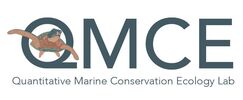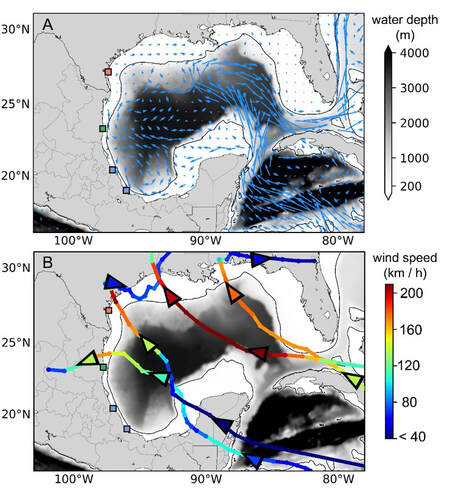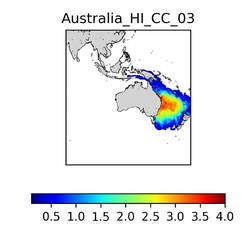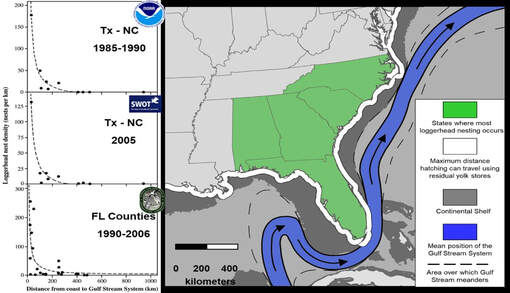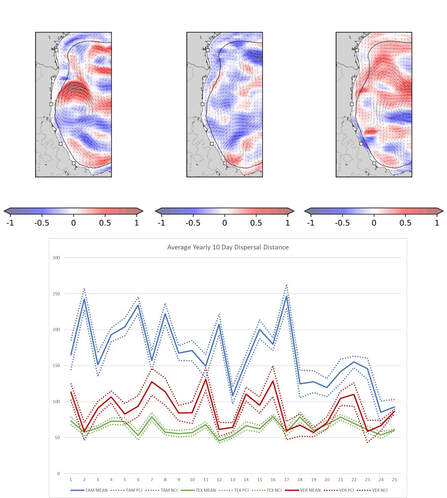Investigators: Susan Piacenza, Morgan DuBois, Nathan Putman (LGL Consulting)
Hatchling sea turtles rely on ocean currents to help carry them offshore and into deeper waters. The more time they spend near the beach, the more they are exposed to the higher density of predators in nearshore waters. Though sea turtles swim towards the open ocean, higher speed currents help to sweep them out to sea more quickly. As such, understanding the current dynamics of individual beaches may be an important but hard to detect aspect of hatchling survival. Ocean circulation models such as HYCOM can be used to accurately show and measure ocean currents from up to several decades ago. Combined with a particle simulator, such as Ichthyop, biologists can study how ocean currents influence the dispersal of hatchling sea turtles. In Kemp’s Ridley turtles, the main nesting beaches within the gulf have widely different dispersal potential. The area with the best dispersal, Rancho Nuevo in Mexico, is used by 90% of the breeding population. For Kemp’s Ridley turtles, our lab is working to quantify the variability between sites, and examine the impacts of hurricanes on the overall dispersal of the species. We are also working to understand how differences in dispersal potential could influence population growth based on site specific hatchling survival by combining the dispersal model with the GSTABM. We are interested in how the differing currents combine with conservation methods to produce a greater or lesser impact. A beach with great dispersal but poor conservation may have a less successful population. We hope that this information can be used in the future to tailor hatchling conservation to the dispersal potential of the site to maximize the success of management. We are working in collaboration with Nathan Putman (LGL Ecological Research Associates).
Hatchling sea turtles rely on ocean currents to help carry them offshore and into deeper waters. The more time they spend near the beach, the more they are exposed to the higher density of predators in nearshore waters. Though sea turtles swim towards the open ocean, higher speed currents help to sweep them out to sea more quickly. As such, understanding the current dynamics of individual beaches may be an important but hard to detect aspect of hatchling survival. Ocean circulation models such as HYCOM can be used to accurately show and measure ocean currents from up to several decades ago. Combined with a particle simulator, such as Ichthyop, biologists can study how ocean currents influence the dispersal of hatchling sea turtles. In Kemp’s Ridley turtles, the main nesting beaches within the gulf have widely different dispersal potential. The area with the best dispersal, Rancho Nuevo in Mexico, is used by 90% of the breeding population. For Kemp’s Ridley turtles, our lab is working to quantify the variability between sites, and examine the impacts of hurricanes on the overall dispersal of the species. We are also working to understand how differences in dispersal potential could influence population growth based on site specific hatchling survival by combining the dispersal model with the GSTABM. We are interested in how the differing currents combine with conservation methods to produce a greater or lesser impact. A beach with great dispersal but poor conservation may have a less successful population. We hope that this information can be used in the future to tailor hatchling conservation to the dispersal potential of the site to maximize the success of management. We are working in collaboration with Nathan Putman (LGL Ecological Research Associates).
